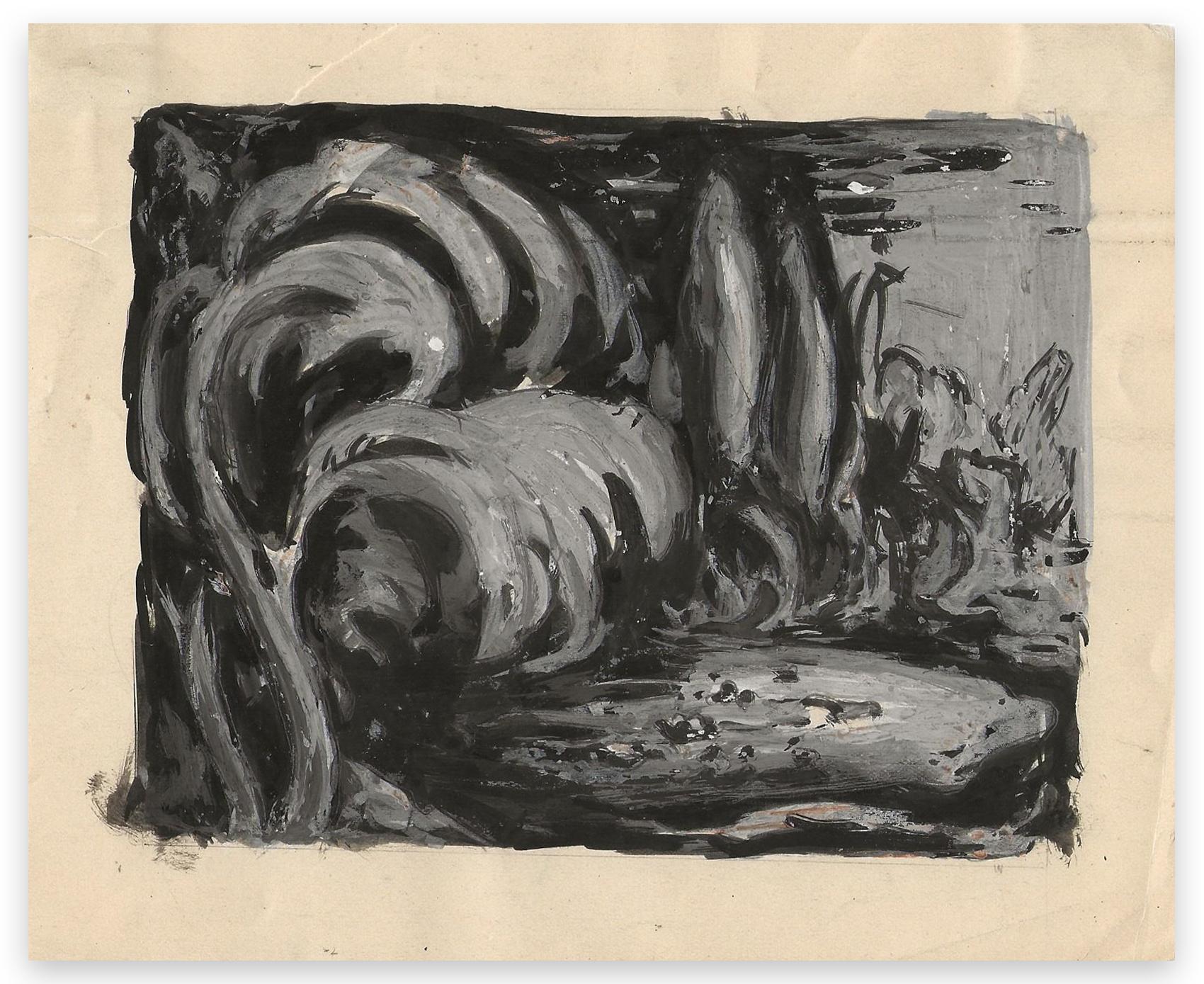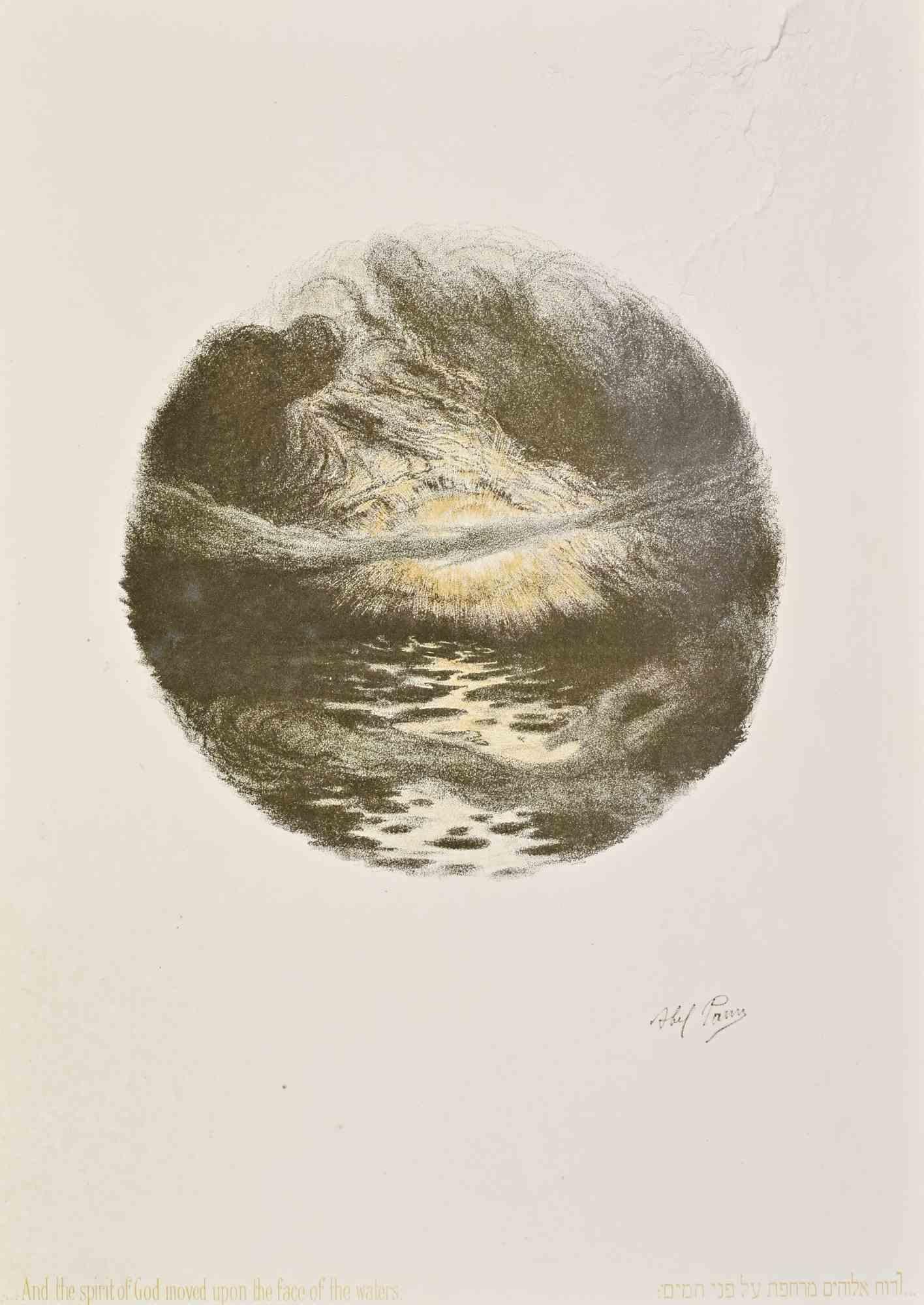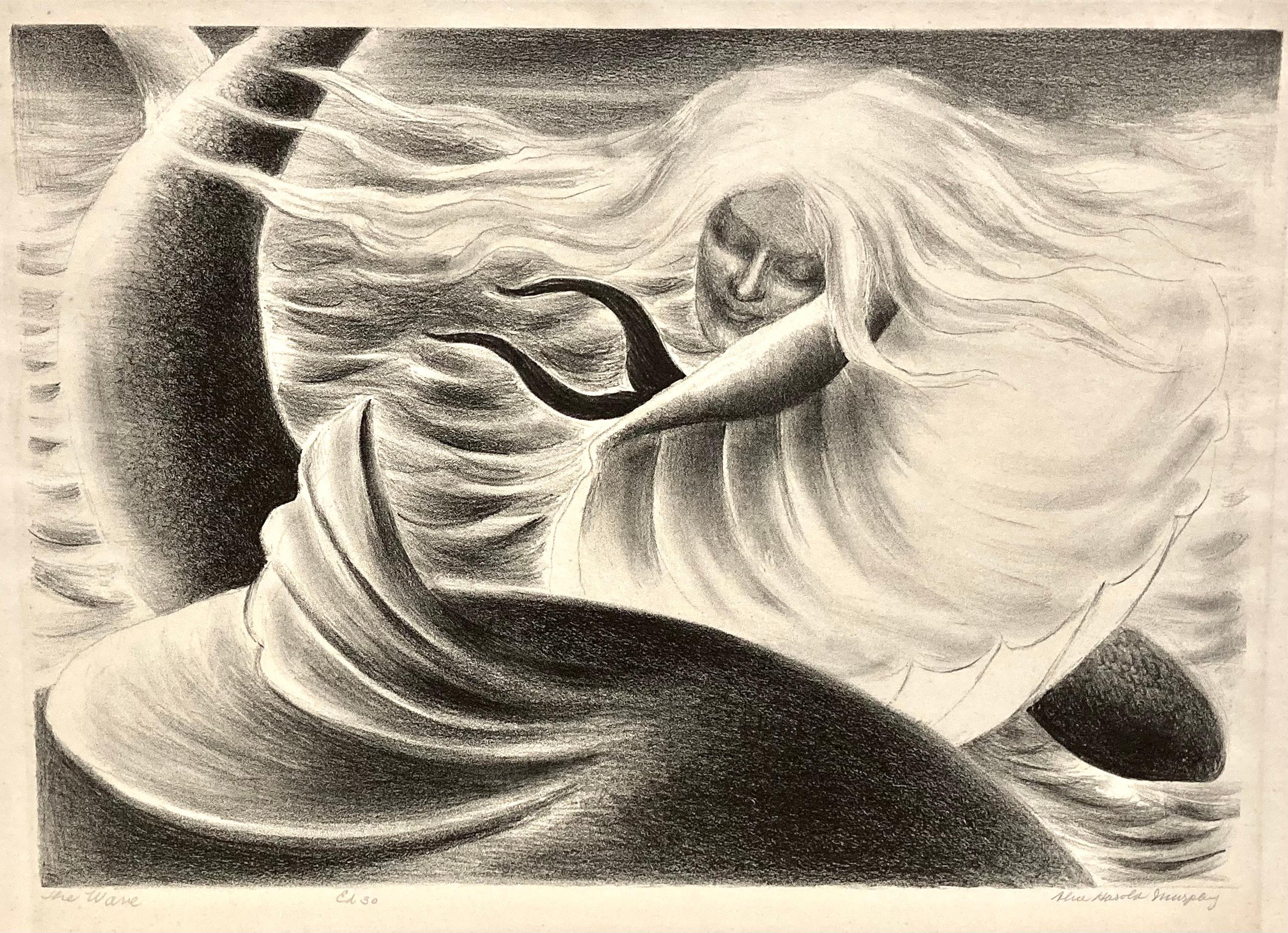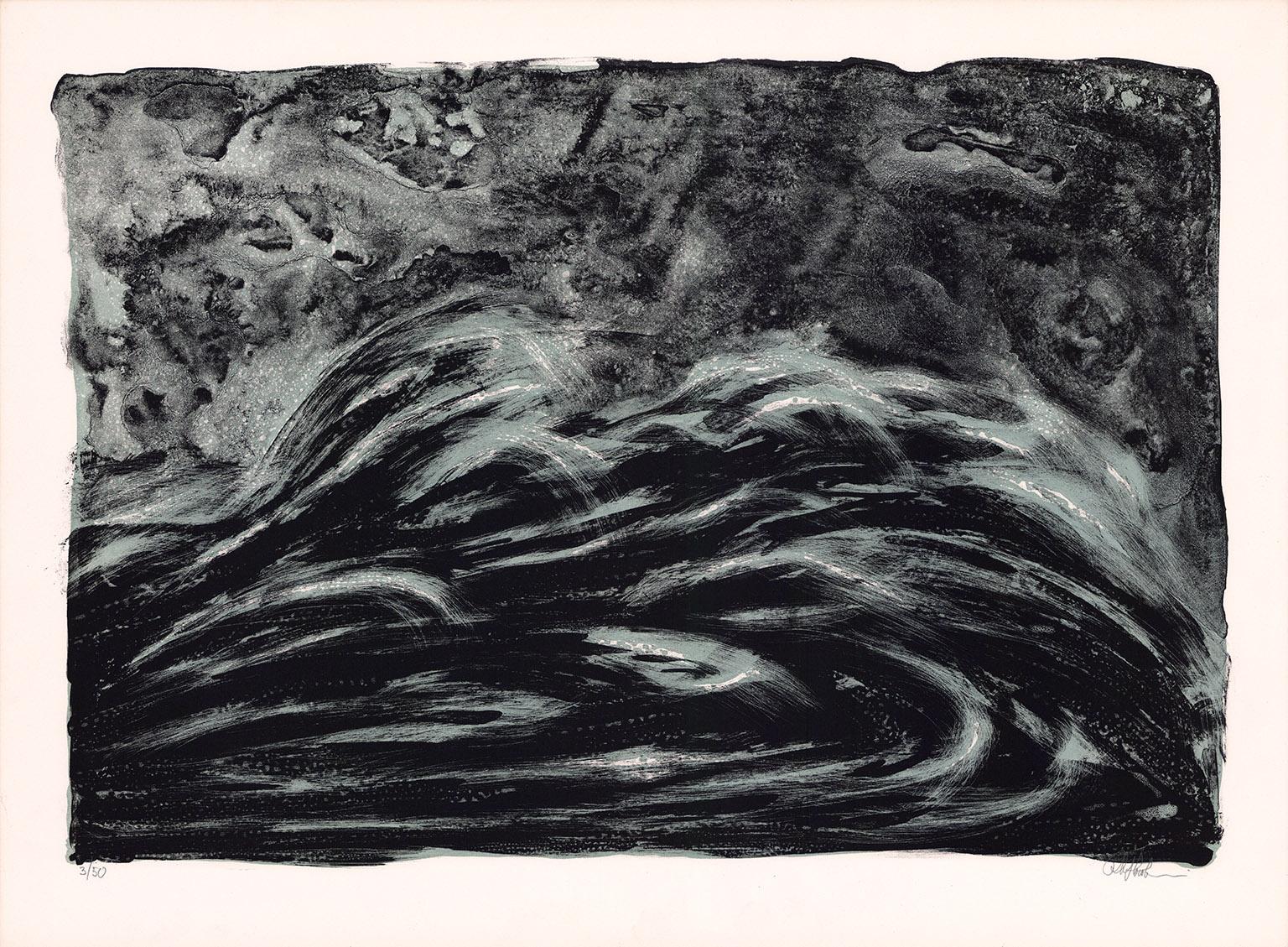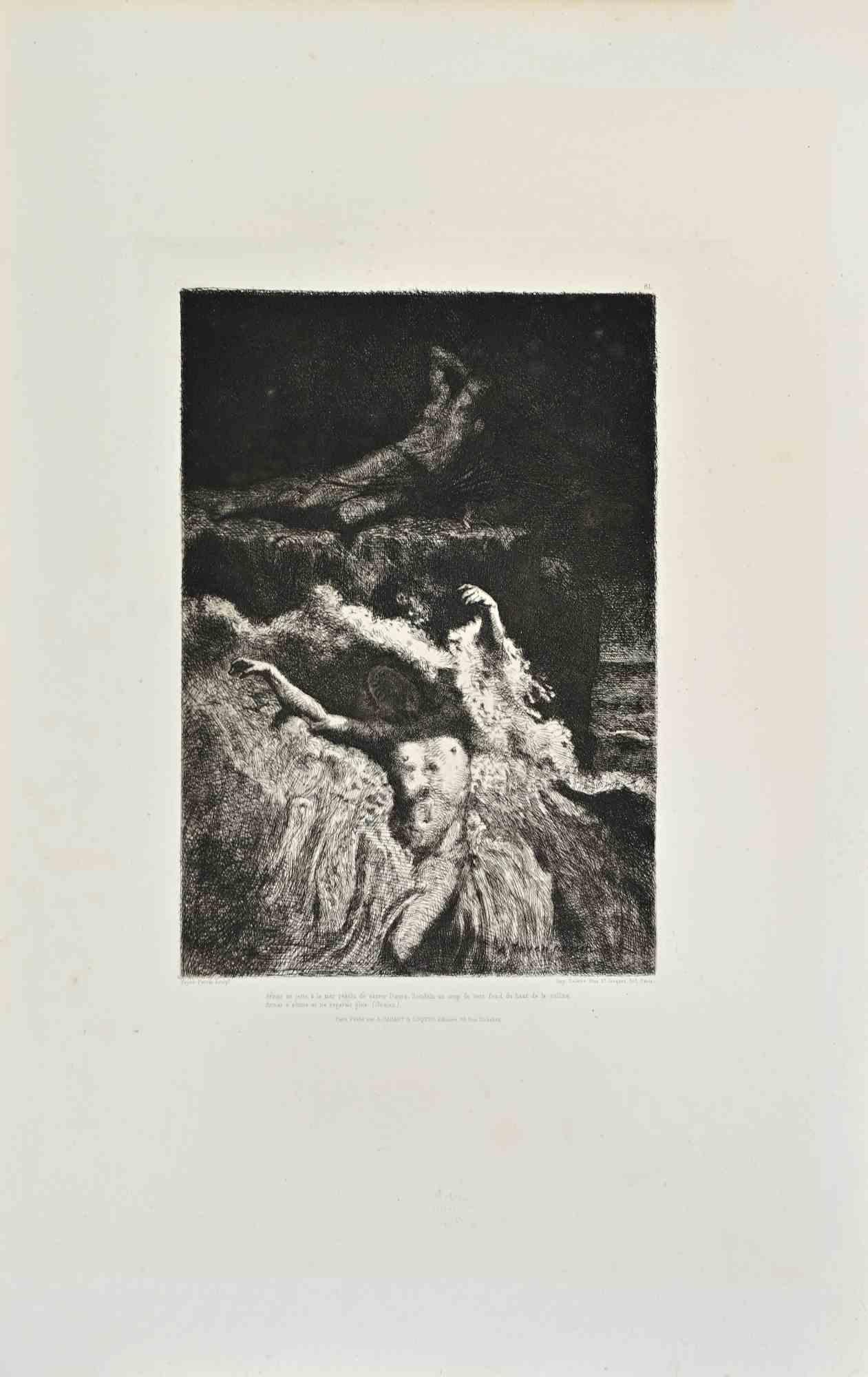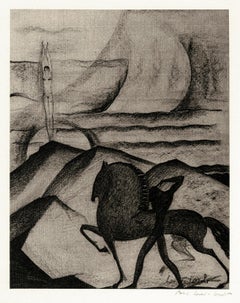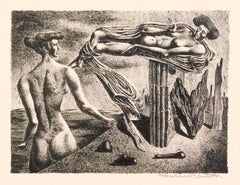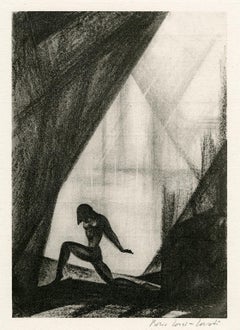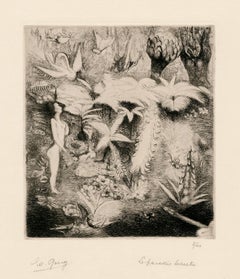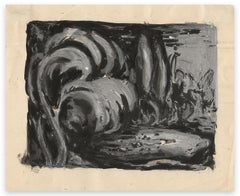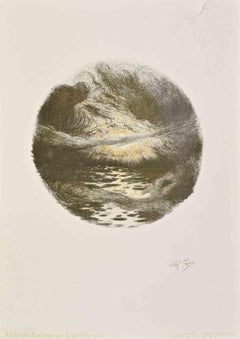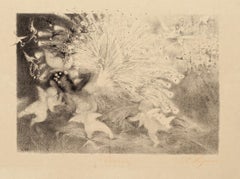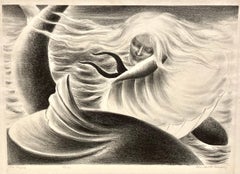Items Similar to 'Vague Lumineuse' (Luminescent Wave) — Late 19th Century Surrealism
Want more images or videos?
Request additional images or videos from the seller
1 of 6
Theophile Pierre Wagner'Vague Lumineuse' (Luminescent Wave) — Late 19th Century Surrealismc. 1895
c. 1895
$750
£583.93
€664.09
CA$1,078.85
A$1,185.31
CHF 619.45
MX$14,135.82
NOK 7,843.93
SEK 7,307.28
DKK 4,962.40
About the Item
Théophile Pierre Wagner, 'Vague Lumineuse' (Luminescent Wave), lithograph, edition not stated but small, c. 1895. Signed and titled in pencil. Initialed in the stone, lower left. A fine, richly-inked impression, on cream wove paper the full sheet with margins (1 1/2 to 1 7/8 inches); pale toning within the previous mat opening, otherwise in excellent condition. Image size 10 1/4 x 16 1/2 inches (260 x 419 mm); sheet size 13 3/4 x 19 7/8 inches (349 x 505 mm). Archivally matted to museum standards, unframed.
A haunting surrealist image of a female nude just visible beneath the surface of a cresting ocean wave.
French artist Théophile Pierre Wagner was active in fin de siècle Paris. His graphic works are included in the collections of the Metropolitan Museum of Art, Musée des beaux-arts du Canada, and the National Gallery of Canada.
- Creator:Theophile Pierre Wagner (French)
- Creation Year:c. 1895
- Dimensions:Height: 10.25 in (26.04 cm)Width: 16.5 in (41.91 cm)
- Medium:
- Movement & Style:
- Period:
- Condition:
- Gallery Location:Myrtle Beach, SC
- Reference Number:Seller: 1039941stDibs: LU53239267062
About the Seller
5.0
Recognized Seller
These prestigious sellers are industry leaders and represent the highest echelon for item quality and design.
Platinum Seller
Premium sellers with a 4.7+ rating and 24-hour response times
Established in 1995
1stDibs seller since 2016
331 sales on 1stDibs
Typical response time: 1 hour
Associations
International Fine Print Dealers Association
- ShippingRetrieving quote...Shipping from: Myrtle Beach, SC
- Return Policy
More From This Seller
View AllRendez-Vous — Early 20th-Century Modernism
By Boris Lovet-Lorski
Located in Myrtle Beach, SC
Boris Lovet-Lorski, Untitled (Rendez-Vous), lithograph, edition 250, 1929. Signed in pencil. Signed in the stone, lower right. From a suite of 10 lithographs published by the artist ...
Category
1920s American Modern Nude Prints
Materials
Lithograph
'Body and Soul' — Mid-20th Century Surrealism
By Federico Castellon
Located in Myrtle Beach, SC
Federico Castellon, 'Body and Soul', 1938, lithograph, edition 30, Freundlich 3. Signed in pencil. Signed in the stone, lower left. A fine, richly-inked, atmospheric impression on cr...
Category
1940s Surrealist Figurative Prints
Materials
Lithograph
Untitled (Nude in Landscape)
By Boris Lovet-Lorski
Located in Myrtle Beach, SC
Boris Lovet-Lorski, 'Untitled (Nude in Landscape)', lithograph, edition 250, 1929. Signed and numbered 5 in pencil. Number 5 of Volume 1, a series of 10 lithographs published by the ...
Category
1920s Art Deco Nude Prints
Materials
Lithograph
$760 Sale Price
20% Off
'Le Paradis Terrestre' (Paradise on Earth) — French Symbolism
By Edouard Goerg
Located in Myrtle Beach, SC
Edouard Goerg, 'Le Paradis Terrestre' (Paradise on Earth), etching, 1931, edition 40. Signed, titled, and numbered '3/40' in pencil. A fine richly-inked impression, on heavy, cream w...
Category
1930s Symbolist Figurative Prints
Materials
Etching
'European Landscape' —Mid-century American Surrealism
By Lawrence Kupferman
Located in Myrtle Beach, SC
Lawrence Kupferman, 'European Landscape', drypoint, edition 50, 1942. Signed, dated, titled, and numbered '7/50' in pencil. A superb, finely nuanced impression, on cream wove paper; the full sheet with margins (1 to 1 3/4 inches); in excellent condition.
Image size 10 7/8 x 13 3/8 inches; sheet size 13 1/8 x 16 1/2 inches. Archivally matted to museum standards, unframed.
An impression of this work is included in the permanent collection of the Syracuse University Art Museum.
ABOUT THE ARTIST
Lawrence Kupferman (1909 - 1982) was born in the Dorchester neighborhood of Boston and grew up in a working-class family. He attended the Boston Latin School and participated in the high school art program at the Museum of Fine Arts, Boston. In the late 1920s, he studied drawing under Philip Leslie Hale at the Museum School—an experience he called 'stultifying and repressive'. In 1932 he transferred to the Massachusetts College of Art, where he first met his wife, the artist Ruth Cobb. He returned briefly to the Museum School in 1946 to study with the influential expressionist German-American painter Karl Zerbe.
Kupferman held various jobs while pursuing his artistic career, including two years as a security guard at the Museum of Fine Arts, Boston. During the 1930s he worked as a drypoint etcher for the Federal Art Project, creating architectural drawings in a formally realistic style—these works are held in the collections of the Fogg Museum and the Smithsonian American Art Museum. In the 1940s he began incorporating more expressionistic forms into his paintings as he became progressively more concerned with abstraction. In 1946 he began spending summers in Provincetown, Massachusetts, where he met and was influenced by Mark Rothko, Hans Hofmann, Jackson Pollock, and other abstract painters. At about the same time he began exhibiting his work at the Boris Mirski Gallery in Boston.
In 1948, Kupferman was at the center of a controversy involving hundreds of Boston-area artists. In February of that year, the Boston Institute of Modern Art issued a manifesto titled 'Modern Art and the American Public' decrying 'the excesses of modern art,' and announced that it was changing its name to the Institute of Contemporary Art (ICA). The poorly conceived statement, intended to distinguish Boston's art scene from that of New York, was widely perceived as an attack on modernism. In protest, Boston artists such as Karl Zerbe, Jack Levine, and David Aronson formed the 'Modern Artists Group' and organized a mass meeting. On March 21, 300 artists, students, and other supporters met at the Old South Meeting House and demanded that the ICA retract its statement. Kupferman chaired the meeting and read this statement to the press:
“The recent manifesto of the Institute is a fatuous declaration which misinforms and misleads the public concerning the integrity and intention of the modern artist. By arrogating to itself the privilege of telling the artists what art should be, the Institute runs counter to the original purposes of this organization whose function was to encourage and to assimilate contemporary innovation.”
The other speakers were Karl Knaths...
Category
1940s Surrealist Abstract Prints
Materials
Drypoint
'Evening' —Mid-Century American Surrealism
By Edward August Landon
Located in Myrtle Beach, SC
Edward Landon, 'Evening', color serigraph, 1958, edition 25, Ryan 71. Signed, titled, and annotated 'Ed. 25' in pencil. A fine impression, with fresh colors, on cream wove paper; the...
Category
Mid-20th Century Surrealist Abstract Prints
Materials
Screen
$680 Sale Price
20% Off
You May Also Like
Waves - Tempera and China Ink Drawing on Paper - Early 20th Century
By Marguerite Callet-Carcano
Located in Roma, IT
Waves is an original tempera and Cina ink drawing on paper, realized by Marguerite Callet-Carcano
With pencil signature on lower right margin.
In very good condition, except for a little missing of paper on lower left margin.
Marguerite Callet-Carcano (Milan, 1878)
Marguerite Callet-Carcano was an Italian-Belgian graphic artist, illustrated books like Drame and Savonarole. Drame by Iwan Gilkin (1926), Les Chimères by Georges Rency (1928), René by François-René Chateaubriand and a reprint by Adolphe by Benjamin Constant. In addition to the xilograph technique, she also used the linoleum one. She engraved the portrait of Charles De Coster...
Category
Early 20th Century Modern Abstract Paintings
Materials
Ink, Tempera
And the Spirit of God Moved upon the Face... - Lithograph by Abel Pann - 1920ca
By Abel Pann
Located in Roma, IT
Lithograph realized by Abel Pann in 1920 ca.
Hand signed lower right.
Good condition except for a big repaired rip in the top right.
Category
1920s Surrealist Abstract Prints
Materials
Lithograph
Reverie (Dream) - Lithograph by Théo P. Wagner - 1870s
By T.P. Wagner
Located in Roma, IT
Reverie (Dream) is an original lithograph on paper realized by T. P Wagner (1819- 1881) in 1870s. Hand-signed on the lower left and titled in red pencil.
Good conditions.
Sheet dim...
Category
1870s Symbolist Figurative Prints
Materials
Lithograph
Alice Harold Murphy, The Wave
Located in New York, NY
The title, The Wave, lends itself to suggesting that the woman (with her long, flowing hair) is personifying the wave. Or is she one with the wave? Is she push...
Category
Mid-20th Century American Modern Figurative Prints
Materials
Lithograph
Waves
By Richard Florsheim
Located in New York, NY
Richard Florsheim created this color lithograph entitled “Waves” in 1973 in an edition of 50 pieces. Printed by Mourlot Press, Paris, this impression is signed and inscribed “3/50” – the third print of fifty. It is in good condition with full original color. The printed image size is 16 3/8 x 23.75 inches and the paper size is 19.75 x 26.50 inches.
RICHARD ABERLE FLORSHEIM...
Category
1970s American Modern Abstract Prints
Materials
Lithograph
Armar se Jette à la Mer - Etching by Auguste Feyen-Perrin - 1870s
Located in Roma, IT
Armar se Jette à la Mer is a black and white etching realized by Auguste Feyen-Perrin (1826-1888) in 1870s.
Titled in the lower.
Image size: 19cmx27cm.
Good condition.
Signed on ...
Category
1870s Modern Figurative Prints
Materials
Etching
More Ways To Browse
Tobias Martin
Toucan Painting
Union Jack Art
Van Gogh Sculpture
Venus Nude Sculpture
Vintage Figure Skater
Wasp Nest
American Country Life
Angel Of Victory
Antique Rabbit Oil Painting
Arabian Horse Painting
Aviation Paintings
B Adams
Balloon Swan
Barber Shop Art
Bedouin Painting
Break In Case Of Emergency
Bronze Sculpture Western
